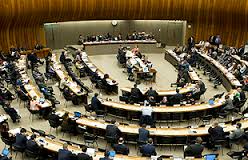HWN Jobs
- KADUNA STATE UNIVERSITY (2016) JOBS
- TRANSQUISITE CONSULTING JOBS
- MEDIFIELD HEALTH SCREENING SUITE (2 SLOTS) JOBS
- ROZEC PHARMACY (2016) JOBS
- NEIMETH INTERNATIONAL PHARMACEUTICALS PLC JOBS
HWN Blogs
- Classical heart healthy foods on HWN BLOGS
- Classical Warning Signs When The Human Liver Begins To Fail on HWN BLOGS
- Myths About Hygiene, Soaps, Germs, Sweat and Smell on HWN BLOGS
- Hernia does not heal on its own on HWN BLOGS
- Classical Essential Oils That Improves Focus Cum Memory on HWN BLOGS
news - 69th World Health Assembly begins in Geneva today on HWN UPDATE back to all News
69th World Health Assembly begins in Geneva today on HWN UPDATE

WHO was established 68 years ago to promote health and ease the burden of disease worldwide. The Organization takes direction for its goals and priorities from the 194 Member States it is designed to serve. Each year, senior health officials from Member States come to Geneva to participate in the World Health Assembly. It is at the Health Assembly that WHO's work is reviewed, new goals are set, and new tasks assigned.
The Sixty-ninth (69th) World Health Assembly this year has a long and complex list of health challenges and responses to review.
The process at the annual World Health Assembly:
At the Health Assembly 2 main types of meetings are held, each with a different purpose:
Committees meet to debate technical and health matters (Committee A), and financial and management issues (Committee B), and approve the texts of resolutions, which are then submitted to the plenary meeting.
Plenary is the meeting of all delegates to the World Health Assembly. The Health Assembly meets in plenary several times in order to listen to reports and adopt the resolutions transmitted by the committees. The Director-General and Member States also address the delegates at the plenary.
In addition, technical briefings are organized separately on specific public health topics to present new developments in the area, provide a forum for debate and to allow for information sharing.
Courtesy: WHO, HWN AFRICA.
: 2016-05-23 06:26:50 | : 1823
HWN News
- First Polish infant to survive on extreme dialysis on HWN MEDICAL MIRACLES
- Drug resistant tuberculosis end game on HWN INSIGHTS
- Too many women opting for caesarean sections (CS) to give birth on HWN SEX EDU
- The intelligent, strong and fearless Nurse that conquered Ebola on HWN ARCHIVE
- Medhi Benatia, down with injury on HWN SPORTS






